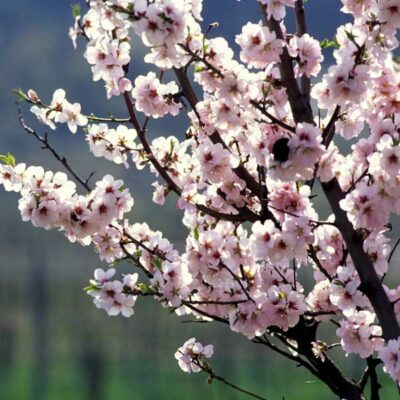Garden Plant: Hall’s Hardy Almond Tree
Product Description: Hall’s Hardy Almond Tree

Productive, Pretty Hall’s Hardy Almond Tree
- 800 Chill Hours
- Beautiful Pale Pink Blooms in Spring
- Late Blooms Protect Against Late Spring Frosts
- Produces Medium to Large Nuts With Hard Shell
- Self-Pollinating, But You’ll Get More Nuts With Several Trees
- Cold Hardy
- Gorgeous Ornamental Edible Plant
- Grows Quickly into a Small, Rounded Flowering Tree
There’s no need to choose between edible plants and ornamental plants. Hall’s Hardy Almond Tree (Prunus dulcis \’Hall’s Hardy Almond’) gives you both in one beautiful package.
Use this small, fast-growing tree to brighten up any sunny area in your landscape. You’ll often get nuts from a single tree, but if you add more than one, they’ll help pollinate each other for larger crops.
They are so pretty in springtime! Masses of pink flowers liberally cover the branches. The display is on par with any other beloved ornamental flowering trees.
Given the right conditions, Hall’s Hardy Almond grows about two feet a year. It won’t take long to reach its full size.
It’s manageable, even when fully grown, and easily works on today’s smaller, modern lots. These vigorous trees are easy to care for and maintain with moderate water usage.
Best of all, You’ll enjoy a harvest of heart-healthy almonds for your snacking and baking needs. The fruit resembles peaches until ripe, then they split to reveal a hard-shelled, peach pit-shaped nut in fall.
We’re proud to offer these expertly grown trees. Hurry, these popular Hall’s Hardy Almond trees won’t last long.
How to Use Hall’s Hardy Almond Tree in the Landscape
This cold-hardy nut tree produces nuts in a geographical region much further north than other varieties. Gardeners in colder zones in the United States can grow Hall’s, including in the Pacific Northwest.
Hall’s can be harvested in fall, once about 75% of the hulls have split. Use the delicious, bittersweet almonds to brew baking extracts, or oven-roast the nuts to sweeten them up. Enjoy your homegrown snacks!
You’ll love the flower display and appreciate the nutrient-rich nuts. Almonds have been studied extensively, and their superfood reputation is well-deserved.
Lower bad cholesterol and gain protein, Vitamin E and essential minerals like riboflavin, potassium, calcium and magnesium. Chew them slowly to settle your stomach!
Consider this small tree as an accent. Line your driveway, or create a special allée with a double row on either side of your walkway.
Hall’s Hardy Almonds make very special patio trees, and can be used in informal groupings. Vary the spacing from 10 to 20 feet and use a loose triangle for a natural look.
Plant them at least 20 feet away from concrete to keep things tidy. We recommend mulching underneath Almond trees.
People across the United States have fallen in love with Victory Gardens again. Use fruiting and nut trees in your landscape design. It’s so easy with stunning varieties like Hall’s Hardy Almond Tree.
Have a tiny lot? Try summer pruning for size control. It’s easy to keep trees under 8 feet for a more manageable harvest. Be sure to watch our YouTube videos to learn more about Backyard Orchard.
Pro Plant Tips for Care
Plant this hardy tree in full sun with at least 6 hours of direct sunlight for best results. Morning sun is best, as it quickly dries the foliage.
Well-drained soil is also a must. Improve drainage by adding soil in a mound 12 to 18 inches tall by 3 feet wide. Plant in that mound.
Almonds need a moderate amount of water on a regular basis, especially during nut production. Apply a thick layer of mulch over the root system and spread to 3 feet outside the canopy. Allow 6 inches of clearance around the trunk for air circulation.
Remove crossing branches in the interior of the tree in late winter. The goal is to increase the sunlight and air circulation in the canopy.
Almonds ripen from the top of the tree down. Harvest by shaking the tree, or using a small stick to knock the branches. Rake litter away from the base of your tree and add the spent hulls to your compost pile.
Add one or more Hall’s Hardy Almond Trees to your landscape. Place your order now, as many other homeowners are on the hunt for these valuable trees.


